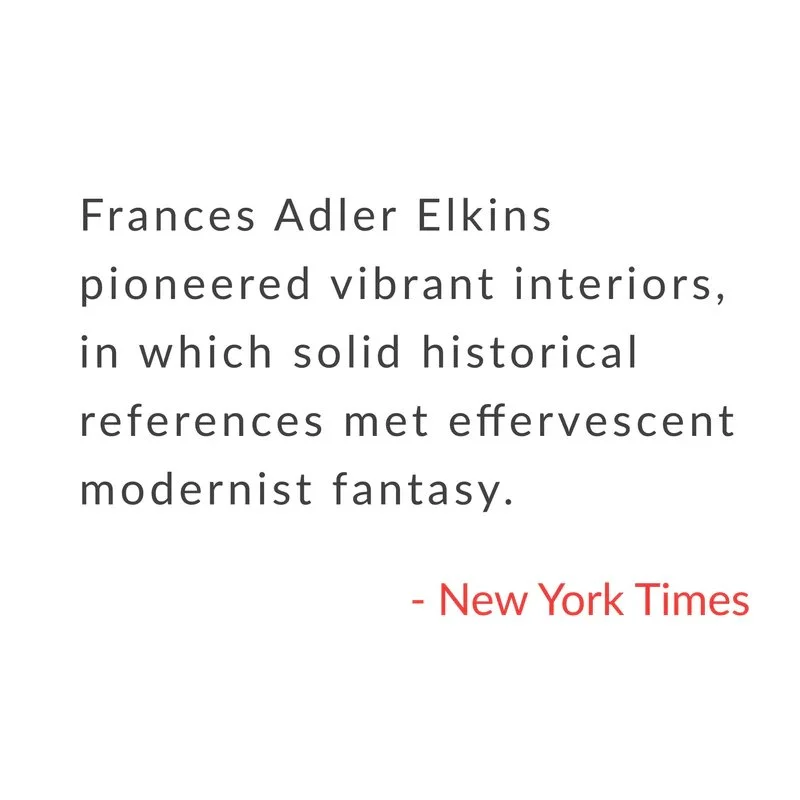Interior Designer Profile: Frances Adler Elkins
Born in 1888, and with an interior design career spanning three decades, Frances Adler Elkins has been called “the first great California decorator.” Her interior design styles ranged from (and combined) art deco to country French, chinoiserie to modern. Even though she wasn’t especially known for including small or large planters in her designs, she was fond of carnations and often staged clients’ homes with them.
Experience is the Best Teacher
Elkins was never formally trained in design; instead, she had an informal education while a teenager as she joined her older brother - later to become renowned Chicago architect David Adler - on his travels through Europe while he was studying architecture in Paris from 1908-1911. Elkins spent 3 years abroad with her brother, exploring the castles, cathedrals and manor houses of France, Italy and Germany. In Paris, the brother-sister team visited the studios of many avant-garde artists and designers, and Elkins was inspired and forever changed by the future-looking art to which she was exposed.
A Career Begins - at Home
This European experience formed Elkins’ interior design styles, even though she didn’t formally begin her decorating career until a few years after her return from Europe. Upon her return, she married, had 3 children, and divorced. While she had undertaken a major design project during her marriage - restoring the 1830’s adobe home Casa Amesti that she and her husband had purchased in Monterey, California - it was following her divorce that she began formally decorating for friends and clients to help support herself and her children.
Her wild success collaborating with her brother to restore Casa Amesti brought her two things: 1) attention and, eventually, commissions from her society friends in nearby areas, including Pebble Beach, and 2) a lifelong collaboration with her architect brother, with whom she teamed on numerous design projects throughout the 1920’s and 30’s. Casa Amesti - sophisticated yet inviting, with its creative mixture of chinoiserie, French and English period furnishings, and a color palette of blue, yellow and white (her favorite) - was Elkins’ career launching pad.
Clients and Interior Design Styles
One of her first paid commissions was for a good friend’s colonial-style home in Monterey. As would be the case for many of her future designs, she combined more classical pieces like Chippendale furniture, Queen Anne mirrors and Ming screens with more modern touches like lamps by French Modernist Jean-Michel Frank. Elkins continued to receive commissions for homes in Pebble Beach, she collaborated with her brother on homes on Chicago’s North Shore, and eventually designed private and commercial spaces in California’s Bay area, as well as in southern California for several Hollywood elites.
Elkins decorated the interior of the legendary golf club, Cypress Point, in a French Provincial manner, creating rooms that were relaxed and informal - a goal of hers for all her nonresidential commissions. Later in her career, she became a distributor of the furnishings and lamps of Jean-Michel Frank and Alberto Giacometti, and she opened her own studio, employing artisans to create pieces of her own design, and to reproduce her favorite furnishings and accessories.
Elkins’ Influence - Past and Present
According to historians, Elkins’ influence on the people whose homes she designed extended beyond her interior decorating choices. She also instructed clients how to set their table, what china, silverware, and linens to use, and even how to arrange flowers. Ms. Elkins only allowed pink and red carnations in her homes.
To emulate Elkins’ interior design styles, today’s designers would do well to include a mix of classic and modern elements, paying special attention to fabrics, furniture and color, and to integrate small planters or round planters with colorful flowers throughout a room’s design to capture some of the mood that Elkins loved.




















